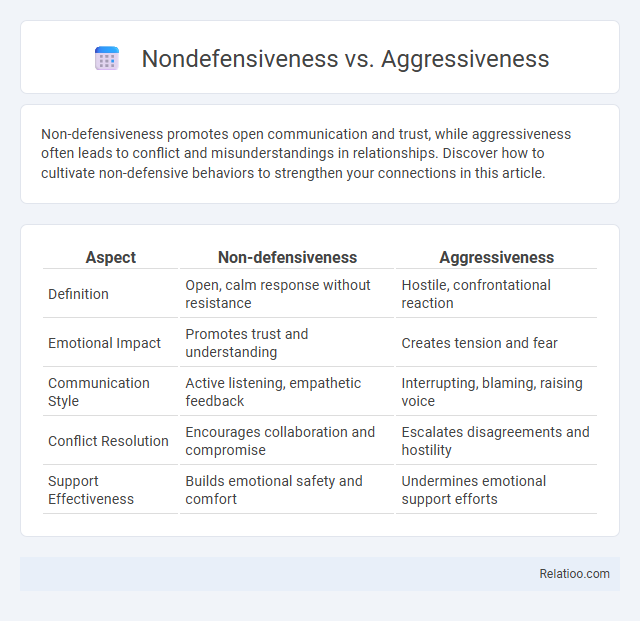Non-defensiveness promotes open communication and trust, while aggressiveness often leads to conflict and misunderstandings in relationships. Discover how to cultivate non-defensive behaviors to strengthen your connections in this article.
Table of Comparison
| Aspect | Non-defensiveness | Aggressiveness |
|---|---|---|
| Definition | Open, calm response without resistance | Hostile, confrontational reaction |
| Emotional Impact | Promotes trust and understanding | Creates tension and fear |
| Communication Style | Active listening, empathetic feedback | Interrupting, blaming, raising voice |
| Conflict Resolution | Encourages collaboration and compromise | Escalates disagreements and hostility |
| Support Effectiveness | Builds emotional safety and comfort | Undermines emotional support efforts |
Understanding Non-Defensiveness and Aggressiveness
Non-defensiveness is characterized by open communication, active listening, and accepting feedback without hostility, fostering effective conflict resolution and emotional intelligence. Aggressiveness involves confrontational behavior, dominance, and often disregards others' perspectives, leading to heightened tension and impaired relationships. Understanding these differences helps individuals cultivate non-defensive responses, promoting empathy and constructive dialogue while reducing misunderstandings and interpersonal conflict.
Key Traits of Non-Defensive Communication
Non-defensive communication is characterized by openness, active listening, and emotional regulation, allowing individuals to respond calmly without feeling threatened or reacting with aggression. Key traits include acknowledging others' perspectives, maintaining respectful dialogue, and focusing on problem-solving rather than blame. This approach contrasts sharply with aggression, which often involves hostility and domination, and with defensiveness, which typically entails denial or counterattacks to protect self-image.
Characteristics of Aggressive Behavior
Aggressive behavior is characterized by hostility, dominance, and a tendency to intimidate or control others through verbal or physical actions. It often involves a lack of empathy, excessive assertiveness, and a disregard for others' feelings or rights, leading to conflicts and strained relationships. Unlike non-defensiveness, aggressive individuals rarely accept criticism calmly and tend to respond with anger or confrontation.
Emotional Impacts: Non-Defensiveness vs Aggressiveness
Non-defensiveness fosters emotional openness and trust, reducing conflict by encouraging active listening and empathy. In contrast, aggressiveness often triggers emotional distress, fear, and hostility, escalating tensions and damaging relationships. Prioritizing non-defensiveness enhances emotional regulation and promotes healthier communication dynamics.
Common Triggers for Defensive and Aggressive Responses
Common triggers for defensive and aggressive responses include perceived threats to self-esteem, criticism, misunderstandings, and feeling undervalued or attacked. Your emotional reaction often hinges on how your brain processes these threats, either by creating a protective barrier (defensiveness) or by initiating confrontation (aggressiveness). Recognizing these triggers helps you manage responses more effectively, reducing conflict and fostering clearer communication.
Benefits of Cultivating Non-Defensive Attitudes
Cultivating non-defensive attitudes fosters effective communication by encouraging open dialogue and reducing misunderstandings, which contrasts with the confrontational nature of aggressiveness and the potential passivity of non-assertiveness. This approach enhances emotional intelligence, allowing individuals to respond thoughtfully rather than react impulsively, thereby improving conflict resolution and maintaining healthier relationships. Embracing non-defensiveness also boosts self-awareness and resilience, contributing to personal growth and a collaborative environment.
Detriments of Aggressiveness in Relationships
Aggressiveness in relationships often leads to increased conflict, emotional distancing, and erosion of trust, damaging the connection between partners. Your ability to communicate openly and resolve issues diminishes as aggression fosters defensiveness and resentment, making constructive dialogue nearly impossible. Non-defensiveness promotes understanding and empathy, while aggressiveness undermines these essential pillars, resulting in long-term relational instability.
Strategies to Foster Non-Defensive Communication
Effective strategies to foster non-defensive communication include active listening, where individuals focus on understanding the speaker's message without preparing a rebuttal. Employing open body language and maintaining a calm tone helps reduce perceived threats and encourages honest dialogue. Encouraging empathy and asking clarifying questions can shift conversations away from aggression and defensiveness toward collaboration and mutual respect.
Overcoming Aggressiveness: Practical Tips
Overcoming aggressiveness involves cultivating non-defensive communication strategies that promote understanding and reduce conflict. You can practice active listening, maintain calm body language, and use "I" statements to express your feelings without blaming others. These practical tips help transform aggressive responses into constructive dialogues, fostering healthier relationships.
Building Healthier Connections Through Non-Defensiveness
Non-defensiveness fosters healthier connections by enabling open communication and reducing conflict, unlike aggressiveness which often escalates tension through confrontation. Embracing non-defensiveness allows you to listen actively and respond thoughtfully, promoting empathy and trust in relationships. Prioritizing this approach supports emotional intelligence and creates a foundation for collaborative problem-solving and mutual respect.

Infographic: Non-defensiveness vs Aggressiveness
 relatioo.com
relatioo.com